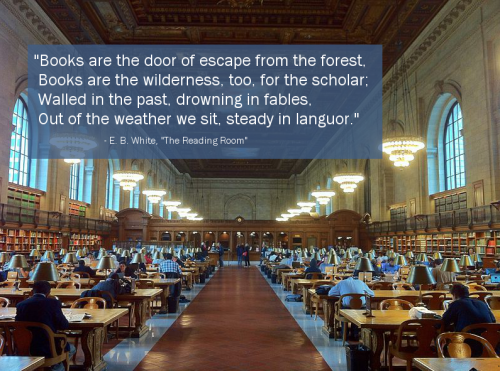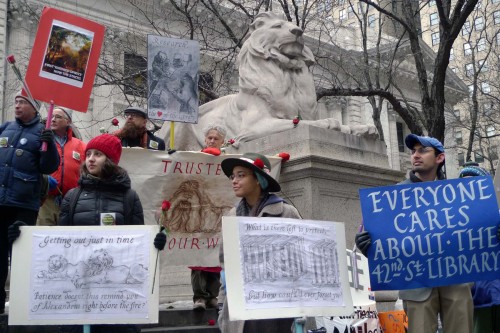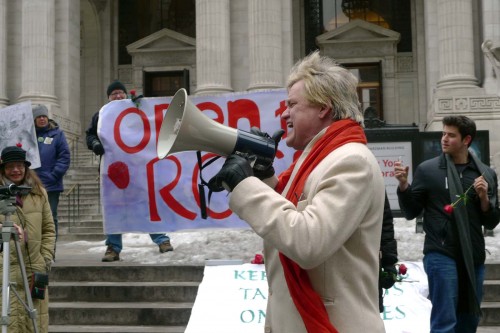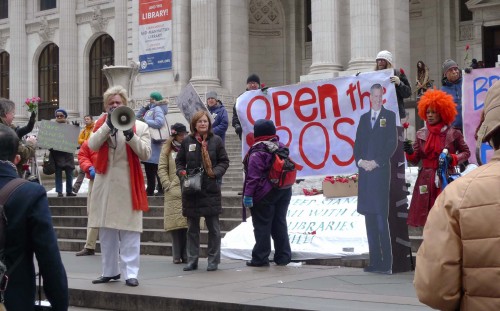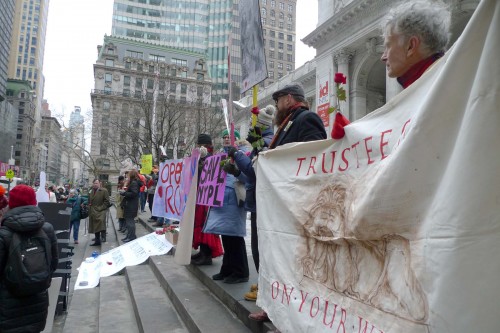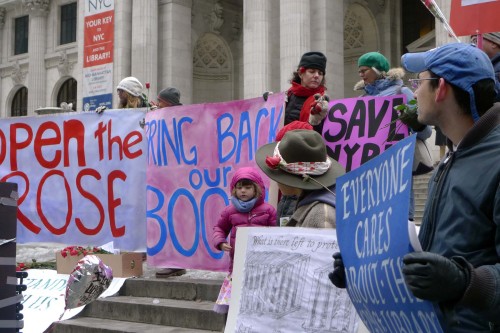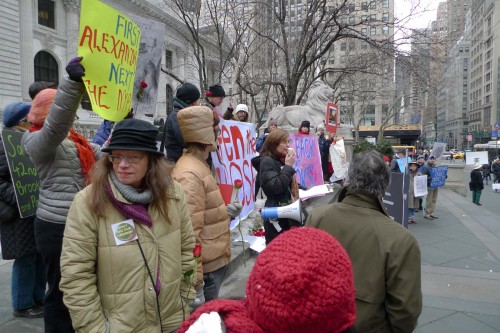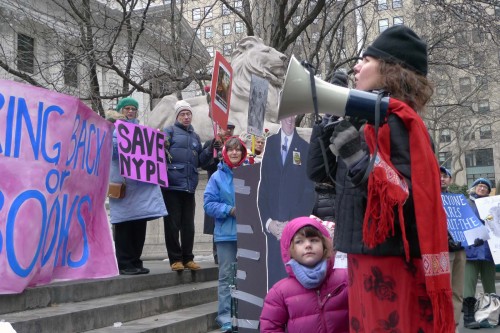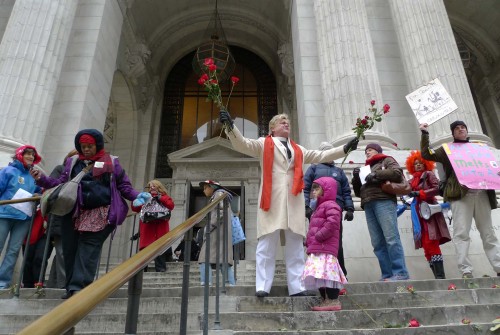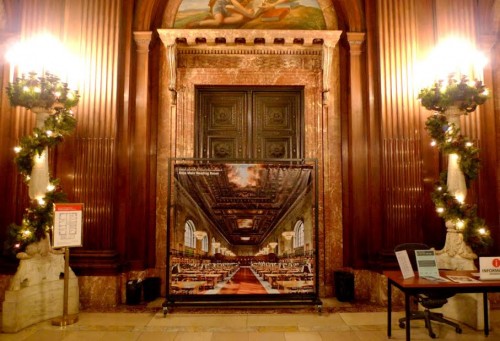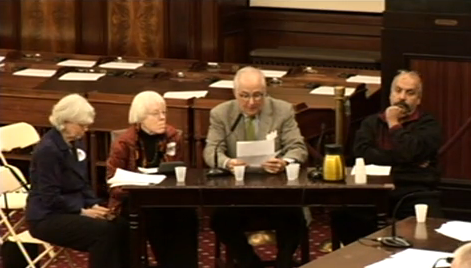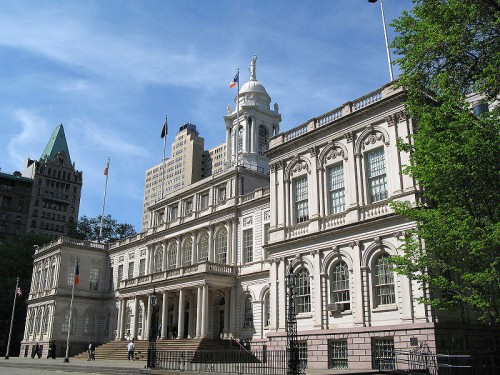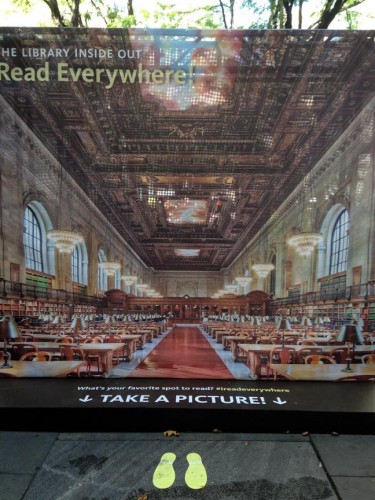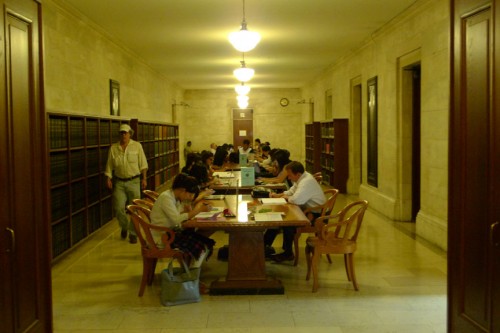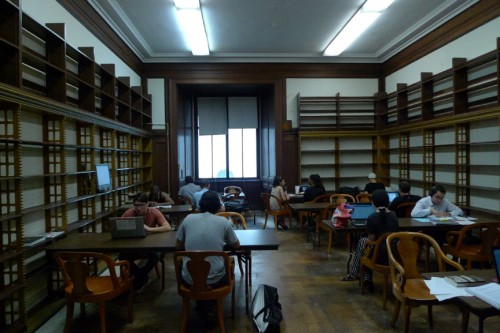NYPL Announces Upcoming Public Meeting
Three million books are overdue!
Sign up here: http://www.nypl.org/midtownmeeting to demand their return to the stacks!
On Thursday March 26th from 6:00 to 8:00 pm in the 42nd Street Library’s Edna Barnes Salomon Room, NYPL will conduct a public session devoted to renovations of the landmark 42nd Street Library and the Mid-Manhattan Branch Library across the street. Mark your calendars, library lovers.
This may be the only opportunity for the public to voice their concerns directly to the NYPL administration. If you want to see the return of three million books that were removed from the stacks, it is critical you attend this event! Do not allow the folly of the Central Library Plan to reappear in a new guise. Speak out to upgrade climate control in the stacks and return the books.
Space is limited, so RSVP today at: http://www.nypl.org/midtownmeeting
A strong turnout will send a clear message to library officials that they cannot continue to ignore the demands of library users. We will be heard!
[ssba]Let’s Make NYPL Great Again
At a time when demand for books in the NYPL system is at an all-time high, the removal of three million books from the 42nd Street library, and numerous books from the Science Industry and Business Library and the Library for Performing Arts, has diminished these formerly first-class research libraries. Many of these books have been exiled to the ReCAP facility in New Jersey and retrieval times for them can extend for days. NYU, Columbia University and CUNY faculty and graduate students can keep materials off the shelves for up to four months under the MaRLI program. All this has eroded the world’s most democratic research library.
Recently, independent scholar Paula Glatzer wrote to NYPL President Anthony Marx addressing these concerns. Here’s what she had to say regarding the sorry state of library services:
“The kind of scholarship I did can no longer be done at NYPL. I did much of my work at the Performing Arts Library, where the research function has been similarly dismantled. Books are off the premises. Open shelves filled with reference books in the third-floor research area have been emptied. Worst of all, there are no reference librarians in the research rooms—rendering those special collections almost useless.
One of the best things in my Lear essays is a “fresh” quotation from a major critic. I found it in a publisher’s advertisement in a mid-20th-century book, which I wouldn’t have seen if I hadn’t been reading the original. (The ad will also be lost to digital readers, because it won’t be scanned.) Another find was a review of Olivier’s early Lear in a rare magazine. Recently, when I went to PA to confirm my sources, I couldn’t find either item. There was no reference help on the third floor; I was sent downstairs to ask the lone librarian at the circulation desk. I was about to delete both quotes when I ran into a librarian I knew, who helped me.
What I cannot fathom is why the NYPL would jeopardize what the library was created for: books stored on site, for easy access, available to all. Instead, you have created a system that is difficult, inefficient and undemocratic. NYPL used to be open and available to anyone who walked in. Now a reader has to have many, scattered, days of free time. The system virtually requires e-mail and high-speed internet, which, as you often say, excludes a third of New Yorkers.
The inefficiencies of the online catalogue and the delivery system are roadblocks. Even with the old card catalogue, which was so much more complete, I knew that for many requests I would get a slip sending me to the reference desk. Sometimes I had made an obvious mistake. But often it became a learning experience with the librarian, where we figured it out together. We almost always found what I was looking for. And it all happened in real time: the call slip, the rejection, the assistance, the find. Now you can waste a week and never get your book.”
You can read the entire letter here.
Last week, Mayor Bill de Blasio unveiled his Preliminary Capital Budget for the fiscal year 2016. An analysis by the Independent Budget Office revealed that the library administration has squandered an astonishing $14.25 million of the taxpayers’ $151 million allocated to the now abandoned Central Library Plan—in addition to millions more wasted on the plan from other sources. The budget also revealed the City Council has allocated an additional $5 million in funds to NYPL’s vaguely described “Midtown Campus Renovation.”
NYPL maintains they cannot afford to upgrade the climate controls in the stacks. This is hard to believe, considering they currently have $141.75m in capital funds at their disposal. Without factoring in additional revenue from the sale of the remaining two floors of SIBL, NYPL would have $73.75 million left over to renovate Mid-Manhattan after accounting for the costs to upgrade the stacks and the second level of BPSE ($46m and $22m respectively according to NYPL estimates).
With library officials now engaging in the critical planning phase for library renovations, the NYPL administration must recognize the importance of keeping physical collections on-site.
Thanks to significant public outcry, we were able to defeat the misguided sale of Mid-Manhattan and the demolition of historic stacks. Now let’s bring the books back to their rightful home in the 42nd Street library!
***
Have you encountered slow or missing books at NYPL? If so, we’d like to hear from you! Please write to us about your experience at info@savenypl.com. Your voice is critical to ensuring library officials remain committed to safeguarding our library’s valuable collections.
[ssba]Library Lovers Converge On 42nd St. for Valentine’s Day
A big thanks to everyone who braved the elements to attend our Valentine’s Day rally outside the 42nd Street library yesterday! It was great to see so many dedicated individuals show their support for the defense of public libraries. Although it was bitterly cold, Rev. Billy warmed our hearts with his fiery oratory.
Framed by Edward Potter’s Patience and Fortitude, library advocates delivered impassioned speeches decrying the actions of out-of-touch trustees and demanding the books be returned to the stacks. Chanting “Bring back the books!” and “Open the Rose Reading Room!” we raised awareness about the imperiled research library to the countless pedestrians along Fifth Avenue. The rally ended with a solemn procession up the monumental library steps to lay roses at the entrance in honor of our beloved Rose reading room and the empty stacks that truly serve as the heart of this great building.
Yesterday’s demonstration was only a small part of our ongoing efforts to bring greater accountability to the New York Public Library. We will not rest until library officials acknowledge the need for more transparency and public input when planning for the library’s future.
Photographs courtesy of Zack Winestine.
[ssba]On Valentine’s Day, Show Some Love for the 42nd St. Library!
On Valentine’s Day, show some love for the 42nd Street Library. Tell NYPL: Return the books to the stacks and reopen the Rose Main Reading Room ASAP!
Join Reverend Billy and the Stop Shopping Choir outside the 42nd Street Library this Saturday at noon to ask, Why is it taking so long to reopen the Rose Main Reading Room? When will the books be returned to the stacks? When will the NYPL trustees make their decision-making transparent to the public?
Show your love for the Rose Reading Room by wearing red and bringing a rose for the Rose.
Saturday, Februrary 14
Noon – 1:00 PM
5th Avenue entrance to the 42nd Street Library (at 5th Avenue and 41st Street)
The Rose Reading Room has been closed since June 2014, when a piece of the decorative ceiling crashed to the floor. It has taken NYPL over eight months just to erect scaffolding to start the inspection process. In the meantime, readers are crowded into small, poorly lit and poorly ventilated rooms with ad hoc provision for computers.
In 2013, the New York Public Library Trustees hastily removed 3 million books from the stacks at 42nd Street to temporary storage in upstate New York. The books were then moved again to remote storage in central New Jersey. Many books that previously took minutes to obtain now take days. Books may have been lost or damaged in the shuffle making them unavailable to readers who rely on the library. Meanwhile, the historic seven-story tall book stacks in the 42nd St. building remain empty.
How long will the 42nd Street library continue with absent books and the Main Reading Room closed? Does NYPL care about its readers?
Come out on Valentines Day and tell NYPL: New Yorkers care, we love our books and the Rose Main Reading Room!
Invite your friends to the facebook event.
[ssba]Bring Back the Books!
Rose Reading Room – CLOSED
Gottesman Exhibition Hall – CLOSED
Bookstacks – EMPTY
Readers, scholars, and library users at the 42nd Street Library report that delivery of requested books is often delayed for days or weeks. Some books are reported missing. In 2013 NYPL hastily moved 3 million books from its stacks at 42nd Street to remote temporary storage in upstate New York before additional space in Princeton New Jersey was ready. Then they moved the books again. We worry that important parts of the research collection have been lost in the shuffle making them unavailable to readers who rely on the library. NYPL officials continue to claim that books are delivered in 24 hours. We urge library users to report delayed or missing books to: info@SaveNYPL.org
The Rose Reading Room has been closed since June 2014, when a piece of the decorative ceiling crashed to the floor. It has taken eight months just to erect scaffolds for safety inspections. In the meantime, readers are crowded into small, poorly lit and ventilated rooms with ad hoc provision for computers. Now a piece of the Gottesman Exhibition Hall’s intricately carved Maurice Grieve ceiling has fallen, and it too has been closed for two to three months.
How long will the 42nd Street library go with closed rooms and absent books? Does NYPL care?
[ssba]Essential Reforms Needed at NYPL – Share Our City Council Testimony With Elected Officials
We’d like to thank everyone who attended last week’s City Council hearing. Below you can read a copy of the testimony we submitted before the Council. We are sending out copies to elected officials, and you can too!
We recommend sending a polite email to City Council Member Jimmy Van Bramer (jvanbramer@council.nyc.gov), Chair of the Committee of Cultural Affairs, and Council Speaker Melissa Mark-Viverito (mviverito@council.nyc.gov) encouraging them to read our testimony and work with us as we strive to make the library administration accountable to the people whose tax dollars fund our libraries. Simply download the PDF version and attach it in your email. You may also want to cc City Council Member Costa Constantinides (costa@council.nyc.gov), Chair of the Sub-Committee on Libraries.
Be sure to let them know that you want NYPL to conduct future capital projects with greater transparency, upgrade the climate controls in the 42nd Street library’s stacks, return the 3 million books that were exiled to storage in New Jersey, and abandon their misguided plan to sell the Science, Industry and Business library.
. . .
Testimony of Charles D. Warren of the Committee to Save the New York Public Library before the New York City Council Committee on Cultural Affairs, Libraries and International Intergroup Relations, jointly with the Subcommittee on Libraries. December 10, 2014
I am Charles Warren and I represent the Committee to Save the New York Public Library (CSNYPL), a citizens group that has sought to keep the popular Mid-Manhattan Branch as a library rather than a real estate deal, keep three million books in the stacks of the Central Library at 42nd Street, and maintain the Science Industry and Business Library (SIBL), the library closest to the CUNY Graduate Center.
With the support of thousands of New Yorkers, students, librarians, celebrated authors, union leaders, elected officials, and others we insisted that the $300 million price tag for the Central Library Plan (CLP), which escalated to $500 million, was too high. Thanks to our efforts and the elected officials who recognized the wasteful folly of this plan, we have stopped it.
The election of 2013 brought a new energy to our city government and the abandonment of NYPL’s destructive and extravagant Central Library Plan gives us all the opportunity to set a better course for the future. Base-line budgeting for the operating budgets of the three library systems is a positive step. And now, we welcome the opportunity to rethink the capital spending budget for our city’s libraries. As you know the many years of under-funding have left a pressing need for intelligent planning and stable funding.
The Center for an Urban Future has performed a great service in its careful study of the branch libraries and I want to add to that with some comments about what NYPL is calling the Midtown Campus, a scheme that encompasses its research library on 42nd Street and the popular Mid-Manhattan Library across 5th Avenue. I urge you to see that these two libraries are intertwined with and complimentary to the citywide network of neighborhood branches. Their central location and unique resources extend their importance beyond NYPL’s three borough system – they serve the whole city.
Public money and Private control – Is that a public/private partnership?
To citizens of New York it seemed the $151 Million contributed by New York City to the Central Library Plan was conjured from thin air; $100 Million from the Mayor; $50 Million from the City Council; $1 Million from the Manhattan Borough President. This money was granted when NYPL claimed it did not yet have even schematic designs. There were no public hearings, there was no public input. Now, most of this sum remains in the adopted FY 2015 capital budget. What is it for?
The NYPL Midtown Campus includes the Central Library at 42nd Street and the Mid-Manhattan Branch, but it fails to mention the Science Industry and Business Library, (SIBL) just a few blocks away.
Will the city council follow the old pattern where it grants $151 Million for a vaguely described plan being developed in secret? We need to know what our tax dollars are paying for. We must not stand for a partnership where the money is public and the decisions are private.
Just last week NYPL conducted a survey about plans for the Midtown Campus, but the survey omitted key questions. They did not ask:
• Does it make sense to leave the stacks empty for want of modern climate controls?
• Which Midtown Campus building is best suited to which library service?
• Should SIBL be sold or made part of the Midtown Campus?
• What balance should we strike between books and electronic services?
Instead, all the poll questions were skewed to avoid these important choices and reinforce a narrow set of pre-determined outcomes. This cannot be presented as meaningful public consultation.
If NYPL will not ask difficult questions, we must. And we must add a budget question: What is the best, most resilient, least destructive, and most economical way of achieving the public’s objectives for the library and the city? Long term capital plans should encompass all parts of all NYPL buildings.
Mistakes made with an insular process
NYPL is a not-for-profit corporation with a $1.1 Billion endowment. I often disagree with its president, Tony Marx, but I have no doubt that he is motivated by the same devotion to the library and the city that motivates the CSNYPL. I know the NYPL trustees are similarly well intentioned. We should applaud their extraordinary generosity and hard work. But insular decision-making at NYPL has led to a series of bad consequences:
•Ten years and countless millions wasted on the Central Library Plan.
• The fiasco of Donnell Library, where the anticipated real estate bonanza for NYPL has not been realized. Money from the sale of this beloved and busy neighborhood library has been chipped away at by bad deals, long delays, and millions spent to rent substitute space for years. In the end an irreplaceable neighborhood library of about 90,000 square feet will be replaced with a largely subterranean space 1/3 its size.
• SIBL was built at the cost of about $ 100 Million. It is a commercial condominium owned by NYPL, not by the city. But many costs associated with this facility were funded with NYS bonding authority. Should NYPL now be free to sell it without city approval? NYPL is now silent on the future of this huge investment in the “library of the future” (focused on CD-ROMs and an object lesson for those thinking they can predict the course of fast changing technology).
An on-going example of private planning with consequences for public funds is the Research Collections and Preservation Consortium (ReCAP) in Princeton, New Jersey. NYPL continues to spend its capital funds to construct and expand its remote storage facility there. These substantial capital investments are represented as “private funds.” and they are being made outside of New York City. Meanwhile, NYPL refuses to invest in its stacks, the uniquely efficient shelf system at the heart of its city owned 42nd Street building. Without public input, it has decided to leave the stacks empty, warehousing this space like a landlord waiting for an uptick in the real estate market.
Is it efficient to shuttle books back and forth from Princeton on a continuous basis? Is it environmentally responsible? Is it good for the preservation of the books? Is it good for New Yorkers? The answer seems to be that ReCAP is paid for with “private funds” and so it is not subject to city oversight. But “private funds” spent in New Jersey are dollars that are not spent on New York City facilities, and this means fewer jobs in New York. That leaves more needs to be met by city taxpayers and a bigger hole in the capital budget.
The public was barely consulted on these decisions, or consulted after they were set in motion. They have real consequences for library services and a real impact on the city’s capital expenditures. We need reform.
Make all information available to all
In order to make informed decisions about capital projects, the City Council and the public need access to cost and other information for past, present, and future projects. Decision-making is hobbled when public cost data are disclosed, but private cost data are concealed. NYPL leaders promise openness but fail to disclose important information.
For example: At the June 27, 2013 hearing before State Assembly Committee on Libraries, NYPL CEO Anthony Marx testified about CLP:
…. we understand that this plan needs an independent cost estimate and we will provide one as soon as we have an actual architectural design that can be assessed. We are as eager to [do] that as quickly as possible…., but we have to get it right. We also understand the public interest in having a cost estimate done by independent actors of what it would instead cost to make the current stacks work at state of the art preservation or for that matter to renovate the current Mid-Manhattan on site…. We will provide that information. We would love to do it sooner it looks at this point like we won’t have all of that complete till the fall. As soon as we have it we will make it public.
What was finally disclosed in the Wall Street Journal, as CLP was being scrapped, was that its cost had ballooned to $500 Million, that fitting out the unused storage under Bryant Park would cost $24 million (rather than the $8.5 Million NYPL estimated earlier) and that the cost to provide proper environmental controls in the stacks was estimated at $46 Million. No estimates were supplied for renovating the Mid-Manhattan Library, no professional cost-estimator was identified, nor was detail supplied. Indeed, the plans and specifications that formed the basis of these estimates have never been disclosed.
The failure of NYPL to fulfill its promise leaves the City Council and the public in the dark. We are deprived of important information and cost data needed to assess alternatives or estimate present capital plans for these buildings.
A closed book from an institution devoted to information access
Partial, selective disclosure of information is a pattern with NYPL. Its trustees’ meetings are open to the public, but much of the substance of those meetings is hidden within the briefing books provided to the trustees and not made public. I have asked Carey Maloney, the Speaker Mark-Viverito’s new representative to the NYPL trustees, to make his copy of these briefing books public, I have made the same request to the Comptroller’s staff. It should not require a quarterly Freedom of Information Act request to make public the substantive information underlying public meetings. Failure to disclose this information makes a mockery of open board meetings.
Pass-through contracts and NYC Department of Design and Construction
As this Committee knows, there are existing tools to require greater disclosure for the construction of city owned buildings. In a hearing held by this committee on April 28, 2014, the role of the NYC Department of Design and Construction (DDC) in library construction projects was examined. Testimony by Commissioner Peña-Mora and his deputy David Resnick emphasized the safe-guards and requirements for transparency in the DDC process. Under questioning, they compared this openness to the lack of transparency when pass-through contracts are used.
At the September 17, 2014 NYPL trustee meeting Anthony Marx claimed that pass-through contracts allowed the NYPL to deliver library projects at half the cost in half the time (compared to DDC). If this can be verified, it is a remarkable record of efficiency (even considering the lack of Wicks law requirements in pass-throughs contracts) and the city might want to fill vacancies at DDC from the staff of NYPL. But only NYPL has the data to support their claim.
We need to reform the rules for pass-through contracts so the use of some “private funds” does not cast a veil of secrecy over public building projects. I urge you to use the expertise within the DDC to find a more transparent process for these contracts. Absent greater transparency, our tax dollars are spent without sufficient public scrutiny or safe-guards.
Our Position on the capital budget
We support base-line budgeting. We support increased funding for NYPL and the other library systems. We support budget reform that allows for long term planning. These measures are needed to strengthen New York’s libraries.
But reform must accompany these increases and improvements in funding.
When we met with Peter Hatch from the Deputy Mayor’s office he indicated relations between the city and NYPL had entered a new era. But we cannot rely on better inter-personal relationships alone. With increased funding for operations and capital projects we must have greater openness, accountability, and transparency at NYPL. Citizens must be able to participate in decisions about both long and short term plans and we need mechanisms within the government to oversee library expenditures of both public and private funds. These libraries are our buildings. In return for more a more consistent stream of public funds, we must demand a more public planning process.
We urge the following reforms:
• Make increased and long-term capital funding contingent on greater openness and better oversight of NYPL.
• Require advance notice and periods of public comment on NYPL capital expenditures whether funded by the NYC or “privately” by NYPL.
• Reform pass-through contracts to provide better oversight and transparency.
• Use the government’s three appointed representatives as a conduit of information between the NYPL trustees and the public.
• Require a quarterly public report from the Speaker’s representative providing an independent account of NYPL plans.
• Require the disclosure of all information presented at NYPL trustee’s meetings.
• Require disclosure of past cost estimates relating to the Central Library Plan
Contact:
The Committee to Save the New York Public Library
232 East 11th Street
New York, NY 10003
info@saveNYPL.org
Join Us As We Testify at City Hall on Wednesday
At 1:00 pm on December 10th, the NYC Council Committee on Cultural Affairs and the Sub-Committee on Libraries will hold a hearing on capital needs in the Council Chambers in City Hall (see attached). Charles Warren has been invited to testify on behalf of the Committee to Save NYPL. New York Public Library President Anthony Marx will also be testifying and is expected to request an unprecedented increase in capital funding for projects that will have profound effects for our branches and research libraries.
The hearing will be open to the public in the City Council Chamber, and we would like to encourage anyone interested in attending to join us as we demand a halt to the sale of the Science, Industry, and Business Library, the return of the three million books exiled from the 42nd Street library’s stacks, and greater accountability from NYPL leaders to the taxpayers who provide a large part of their funding.
For directions to City Hall, click here. In order to allow time to go through security, we recommend arriving at least 20 minutes in advanced of the hearing.
In addition to attending the public hearing this Wednesday, now is an excellent time to contact your local city council member and borough president. Let them know that the battle to save our libraries isn’t over, that the NYPL must be transparent and accountable to the public when it spends taxpayers’ money, and that this critical public hearing will shape the future of our libraries.
Manhattan Borough President Gale Brewer:
Email: info@manhattanbp.nyc.gov
Phone: (212) 669-8300
Bronx Borough President Rubén Díaz, Jr:
Email: webmail@bronxbp.nyc.gov
General Office: (718) 590-3500
Staten Island Borough President James S. Oddo:
Phone: (718) 816-2000
Email web form
And if you haven’t already participated in the NYPL’s user survey which will guide the Library’s plans for renovation of the 42nd St. and Mid-Manhattan Libraries, please do so here:
http://savenypl.org/nypl-
NYPL Survey Seeks Public Feedback
Appearing to engage library users, the New York Public Library has circulated an online survey to measure how the public uses their libraries. The results will inform their decisions about renovations to the Mid-Manhattan and 42nd Street libraries. Although the multiple choice format constrains complex answers, we recommend responding in ways that encourage the NYPL to return to 42nd Street the 3 million books that have been exiled.
Most of the questions fail to address the diverse needs of library patrons and ask participants to gauge library services according to rigid categories. We urge you to add your own comments wherever possible.
In spite of these shortcomings, we encourage everyone to take a few minutes to participate in the survey. Midway through the survey, you will be asked if you are willing to answer a few more questions. Make sure to answer “yes” since the questions that follow pertain to the Mid-Manhattan Library and the 42nd Street library.
At the end, a prompt will allow you to leave your comments. This is an excellent opportunity to tell NYPL to respect the integrity of Carrère and Hastings’s architecture, return the books to the stacks, and keep reading materials on-site so that both Mid-Manhattan Library and the 42nd Street library continue as the thought provoking center of New York.
Click here to participate in NYPL’s survey.
[ssba]What Will NYPL Trustees Do Now?
Jorge Luis Borges famously described paradise as a kind of library, but recently the New York Public Library has seemed more purgatory than paradise for its many users. Over the last few months, the Rose Reading Room has remained shuttered after a portion of the ceiling crashed to the ground. Can there be any more fitting symbol for the moral decay eating away at New York’s great public research library? Last Wednesday afternoon, the New York Public Library’s Board of Trustees convened a meeting at the Mid-Manhattan Library, and we were there to observe every detail.
Mayor de Blasio and Speaker Mark-Viverito have not yet appointed representatives to the NYPL Board of Trustees. We urge them to appoint independent representatives so that New Yorkers, whose tax dollars provide more than half the funds for NYPL, will be properly represented on the board. This is a crucial step needed to provide the accountability and transparency that has been absent from NYPL planning.
President and CEO Anthony Marx confirmed that Mayor de Blasio and the City Council have approved $151 million in capital funds that were previously allocated for the now defunct Central Library Plan. We note that these funds were approved without public hearings or public comment. At a time when our city’s branch libraries need millions in basic repairs, it is expected NYPL will use the funds to revamp the 42nd Street library and the Mid-Manhattan Library.
NYPL revealed few details about what they are now calling the “Midtown Campus Renovation.” The current phase of the project, which is focused on defining spatial needs for anticipated library programs in the project, is expected to take at least six months. Specific designs for the renovation of the buildings in this plan would not be made until the programming phase and a physical condition assessment is completed.
Marx said that NYPL had been working with the NYC government for almost a year to redesign many aspects of their relationship. He put special emphasis on the need to change the way city funds are allocated to the library. Now that the city has promised to base-line library budgets, NYPL is seeking a dependable capital budget that will allow it to address the needs for capital improvements in what Marx claimed was its two million square feet of space across three boroughs.
Marx explained that construction projects handled by NYPL on a “pass-through” basis – that is, projects where the construction process is managed by NYPL rather than NYC Department of Design and Construction – allowed them to complete projects at half the cost and in half the time. Because projects handled in this way are less transparent, it is difficult to verify this assertion. CSNYPL believes that public funds need to be approved and accounted for publicly. Any scheme that keeps these expenditures from open public scrutiny should be avoided.
During the meeting, Trustee Robert Liberman reported on capital planning projects. Liberman stated the $18 million renovation of Schomburg Center would be done on a pass-through basis and that the new library at the former Donnell site on 53rd Street would start in the fall and be completed at the end of 2015. He mentioned a renovation project at the Woodstock Branch for $9.7 million and another in Rossville, Staten Island for $10.7 million.
Jonathan Bowes presented a summary of the Center for Urban Future’s report on re-imagining branch libraries. CSNYPL will release a detailed response to this report soon.
The board welcomed four new executive officers: Iris Weinshall was named Chief Operating Officer, Christopher Platt as Vice President of Public Services, Carrie Welch as Chief External Relations Officer, and Ryan Cairns as Vice President of Development.
The sale of SIBL was never raised during the meeting. Also unmentioned was the fate of the seven-floors of stacks below the 42nd Street library, which are currently empty following the removal of books in anticipation of the stacks demolition (thankfully thwarted by the efforts of New Yorkers, CSNYPL, and its allies).
CSNYPL believes that a portion of the $151 million in New York City taxpayer funds should be spent to update the climate controls in the stacks of the 42nd Street library. The long promised second-floor Bryant Park Stack Extension (BPSE) has not been started and there was no word of progress towards its realization. Relying on BPSE alone to store the library’s collections does not adequately meet the future needs of New York City’s largest research library, and leaving the stacks empty for want of new air-conditioning and fire suppression systems cannot be a long-term solution.
Disconcertingly, the NYPL has been slow to address the urgent condition of the Rose Reading Room’s ceiling after a plaster rosette fell in May, forcing the closure of library’s largest reading room. According to Liberman, the library is close to signing a contract for scaffolding that will enable experts to examine the condition of the ceiling, but they are not yet ready to begin repairs that will return this crucial facility to public use.
Meanwhile, visitors to the library must use rooms in the second-floor corridor for accessing materials. Many of these rooms suffer from poor lighting, making reading difficult, and many readers report longer than normal retrieval times. NYPL has devised a system to deliver books to readers scattered around the library while the Rose Reading room and its elegant retrieval system are closed. They claimed books are delivered within 45 minutes and said they might make this a permanent feature of the library. When the stacks were being used books were often delivered in 15 minutes.
Stay tuned as we continue to monitor the actions of the NYPL administration and board of trustees. Be sure to follow us on Twitter and Facebook.
(Photograph by Ben Asen, NYPL Digital Collections.)
[ssba]NYPL Unveils Brand New Reading Room!
NYPL has just created this bizarre simulacrum of the Main Reading Room on the plaza outside the 5th Avenue entrance to the 42nd Street Library. According to NYPL,
The project, called “The Library Inside Out” encompasses many elements of the beloved Rose Reading Room with some new features.
Well, yes, if the you think the key elements of the beloved Reading Room are fake lamps (they lack both sockets and electrical connections) and a fake backdrop. Those elements most certainly don’t include any research books – research materials of course are not allowed to leave the 42nd building and obviously can’t be used in this space. But don’t worry, one of the “new features” is the opportunity to take staged selfies:
Meanwhile, the real Reading Room remains closed due to plaster collapsing from the ceiling. Library patrons are forced to work in inadequate and depressing makeshift spaces:
Rumor (and that’s all there is – NYPL hasn’t seen fit to communicate any updates to the public) has it that a full ceiling inspection won’t be undertaken until October and the extent of the damage and necessary repair work won’t be known until then. No repair work is apparently being done at present. The Reading Room will remain closed until at least the beginning of next year, longer if the inspection reveals extensive problems.
[ssba]


